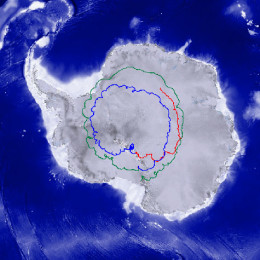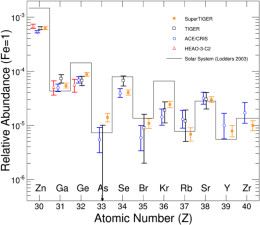
Illustration of cosmic-ray nuclei impacting Earth’s atmosphere and decaying into lighter particles. [ESA]
High-Energy Impacts
Galactic cosmic rays are immensely high-energy protons and atomic nuclei that impact our atmosphere, originating from outside of our solar system. Where do they come from, and how are they accelerated? These are both open topics of research.
One of the leading theories is that cosmic-ray source material is primarily a mixture of material that has been ejected from massive stars — either from supernovae or in stellar wind outflows — and normal interstellar medium (ISM). This material is then accelerated to cosmic-ray energies by supernova shocks.

Number of nuclei of each element detected by SuperTIGER. Note the change of scale between the two plots (click for a closer look)! [Murphy et al. 2016]
Balloon-Borne Detections
Enter SuperTIGER, an experiment designed to collect cosmic rays and measure the abundances of the rare heavy elements — those with atomic number between iron (Z=26) and zirconium (Z=40).

The path that SuperTIGER took over Antarctica during its flight, with a different color denoting each circuit around the pole. Note where it got stuck in an eddy over the Transarctic Mountains at the end of its second circuit! [Columbia Scientific Balloon Facility]
The SuperTIGER team solved these problems by flying their instrument on a high-altitude scientific balloon at 127,000 feet. The project launched in Antarctica, taking advantage of the wind patterns circulating around the pole to maximize the flight time. In the end, SuperTIGER flew for 55 days, shattering the record for longest flight of a heavy-lift scientific balloon (which was previously 42 days). During this time, the experiment detected a whopping 50 million cosmic rays.
Pinning Down Abundances

Measured elemental abundances for galactic cosmic rays, from SuperTIGER (orange) and other experiments. [Murphy et al. 2016]
These results support the idea that a significant fraction of cosmic-ray material originates in associations of young, massive stars, and that the remainder is made up of solar-system-abundance ISM that’s injected and accelerated — possibly by supernova shocks — into cosmic rays.
Citation
R. P. Murphy et al 2016 ApJ 831 148. doi:10.3847/0004-637X/831/2/148
